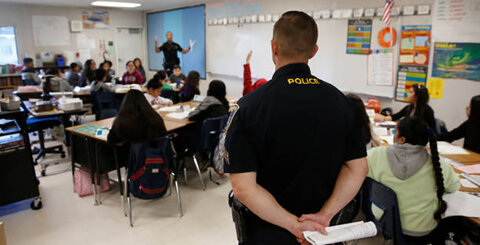Kayla Susalla
The juvenile justice system is distinct from the adult system because it accounts for youth making impulsive decisions due to hormonal changes, lack of experiential learning, and still-developing brains. External factors such as dysfunctional family dynamics and other environmental influences can compound these difficulties. With many factors at play during adolescence, the juvenile justice system is intended to take a primarily rehabilitative approach and divert kids from the adult system through counseling referrals and diversion programs. However, policies that increase kids’ contact with the legal system have become more popular over the years, especially the placement of police in schools.
Studies analyzing the effects of school police on student arrest rates are scarce and often restricted to small samples, making results hard to generalize. The Government Accountability Office (GAO) has helped reduce this gap by comparing public schools with and without school police using a nationally representative sample from the Civil Rights Data Collection (CRDC) and the School Survey on Crime and Safety (SSCS) for the 2015–16 and 2017–18 school years.
The GAO estimated that schools with a police officer present at least once a week had arrest rates 218 percent higher than similar schools without police, and referrals to police 137 percent higher, even after controlling for such variables as the presence of gang activity, racial makeup of schools, neighborhood crime, school location, and school disorder.
“School disorder” includes the reported frequency of student racial/ethnic tensions, verbal abuse of teachers, classroom disorder, gang activity and acts of disrespect for teachers.
The GAO also performed a descriptive analysis of SSCS information, finding consistent results: In SY 2017–18, 29 percent of schools with police experienced one or more arrests, compared to 8 percent of schools without them. In SY 2019–20, 26 percent of schools where police were present reported arresting students, compared to an estimated 7 percent of schools without police.
However, the report did not conclude whether adding police was associated with schools becoming safer, which is the goal of police presence in schools. (Notably, two SROs stopped the shooter in the recent Barrow County, Georgia, attack, likely saving lives).
A major problem is an unclear line between school administrators’ roles and police officers’ authority. Having officers on campus removes geographical barriers for administrators to consult police on disciplinary issues, especially when a part of an officer’s role is to respond to conflict. But when officers handle misconduct in schools with arrests, it can diminish arrested students’ ability to go to college, buy a home, or receive a job offer. School administrators handling misconduct does not. And school administrators, counselors, and other support staff are likely better equipped to address school climate issues due to their training and experience, especially for students with special needs.
Additionally, over-policing can be counterproductive in establishing positive relationships between law enforcement and the communities they serve. For example, the Pasco County Sheriff’s Office created an intelligence-led policing protocol using SROs to “look to identify students who are at risk of developing into prolific offenders,” which they define in part as students with one or more D’s, behind by one credit to graduate, or absent three to four times in a quarter. Labeling students using predictive measures undermines the presumption of innocence, shares unnecessary confidential information, and could make students less likely to trust authority figures at school. Tumultuous relationships between police and the communities they serve are exacerbated by officers’ use of force, which is understudied but has generated jarring videos filmed by students.
Police violence is a broader issue facilitated by weak accountability and reinforced by qualified immunity, which prohibits citizens from suing officers unless a prior case with identical facts found that an officer’s actions were unconstitutional. Indeed, qualified immunity has been used to protect school police from liability for breaking a student’s arm when the student was having an emotional episode and punched a locker, and for tasing a student with a disability when they attempted to leave school. In both cases, school staff would have been better suited to respond and avoid unnecessary harm to students. Police are incentivized to prioritize their own safety, and the system too often fails to hold rogue officers accountable.
The GAO report echoes findings from other research: placing officers in schools increases the severity of disciplinary measures. It is important for policymakers to consider these negative consequences when deciding whether to bring police into schools instead of letting staff handle discipline. The consequences highlighted by current research especially mean the federal government should cease offering grants to states to place officers in schools.
Overall, additional research and reporting on how arrests affect students, more tracking of officers’ use of force in schools, and further analysis of whether police presence enhances school safety, are needed. The GAO report is a step in the right direction.

